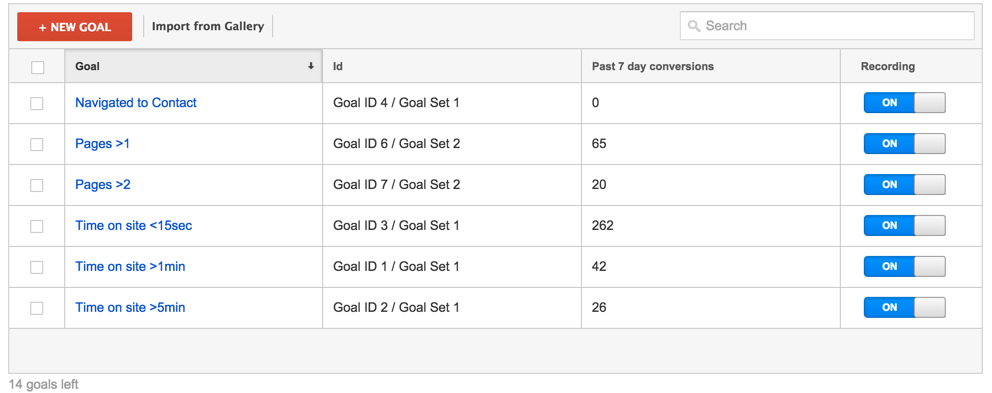What Data Is Google Analytics Goals Unable to Track: A Complete Guide
What Data Is Google Analytics Goals Unable to Track: A Complete Guide
Blog Article
Unveiling the Blind Spots: Comprehending What Google Analytics Goals Can not Measure
In the world of electronic analytics, Google Analytics stands as a powerful tool for tracking and analyzing on-line individual communications. However, amidst its robust capabilities, there exist dead spots that often avert dimension. Recognizing what Google Analytics objectives can not measure is crucial for getting a comprehensive view of customer actions and engagement. As we dig into the details of these blind spots, we reveal a complex web of undiscovered areas that hold useful understandings into customer actions and motivations, difficult traditional wisdom and dropping light on the constraints of our data-driven understanding.
Individual Behavior on External Operatings Systems
Recognizing just how users engage on outside systems is vital for optimizing on the internet approaches. Outside platforms, such as social networks networks, reference sites, and on the internet forums, play a substantial duty in driving web traffic to a firm's site. By assessing user behavior on these platforms, organizations can gain beneficial understandings right into the efficiency of their advertising efforts and the choices of their target market.
One key aspect of individual habits on exterior platforms is the reference source. By tracking where the customers are originating from, organizations can recognize which systems are driving one of the most traffic to their web site. This info can aid firms assign their resources better, focusing on the platforms that produce the most effective outcomes.

Offline Interactions and conversions
Assessing customer behavior on external platforms gives useful understandings right into on-line techniques; nonetheless, considering offline conversions and interactions is similarly crucial for a comprehensive understanding of a business's general performance. Offline conversions, such as in-store acquisitions or phone queries, play a considerable duty in several companies' success.

Attribution Beyond Last Click
When diving right into the realm of electronic advertising analytics, it becomes important to look beyond the single touchpoint of the last click for an extra thorough understanding of attribution. While Google Analytics provides beneficial insights into user behavior, depending entirely on last-click attribution can be limiting - what data is google analytics goals unable to track. look at this now Acknowledgment designs that go beyond the last click use an extra nuanced view of the client trip, considering all the touchpoints that result in a conversion
Attribution beyond the last click allows marketing experts to designate credit score to different communications along the conversion path, giving a clearer photo of the effectiveness of various advertising and marketing networks. By checking out multi-touch acknowledgment designs such as straight, time degeneration, or position-based acknowledgment, businesses can better allocate their advertising budgets and enhance their strategies for optimal impact.
Understanding the impact of each touchpoint in the conversion process is vital for making notified decisions and making the most of ROI. By welcoming attribution past the last click, services can gain much deeper understandings right into client actions and customize their advertising initiatives a lot more successfully.
Cross-Device and Cross-Browser Monitoring

In a similar way, cross-browser monitoring complements cross-device tracking by recording user behavior as they change between different web internet browsers. Recognizing exactly how users interact with websites on various web browsers can assist marketers maximize their on the internet experiences to ensure uniformity and functionality across various systems.
Qualitative Information and Customer Intent
Comprehending customer intent through qualitative data evaluation is important for developing targeted digital advertising and marketing approaches that resonate with the requirements and preferences of the target audience. Qualitative data gives insights into the 'why' behind individual actions, shedding light on inspirations, emotions, and preferences that quantitative data alone can not catch. By analyzing individual feedback, comments, and interactions, marketing professionals can uncover useful details about individual intent, enabling them to tailor their messaging, material, and offerings to much better align with what their audience is seeking.
Qualitative data also helps in comprehending the context in which individuals engage with a web site or application. This contextual understanding enables marketing professionals to create more relevant and personalized experiences, inevitably driving higher interaction and conversion rates. By delving into user intent via qualitative data evaluation, companies can get a deeper understanding of their target audience, causing much more effective advertising strategies that fulfill individuals' expectations and requirements.
Final Thought
To conclude, Google Analytics goals have limitations in determining customer behavior on exterior platforms, offline conversions, attribution beyond last click, cross-device and cross-browser monitoring, and qualitative information associated with individual intent. what data is google analytics goals unable to track. It is necessary for businesses to be aware of these dead spots in order to supplement their information evaluation with various other devices and approaches to gain a much more comprehensive understanding of their target market and boost their general electronic advertising and marketing strategies
By examining individual habits on these systems, services can acquire important insights right into the efficiency of their marketing efforts and the preferences of their target audience.
Examining user actions on see this website outside systems offers weblink useful insights into on the internet methods; nevertheless, taking into consideration offline conversions and communications is just as crucial for a thorough understanding of a firm's total performance.In electronic advertising analytics, relocating past last-click acknowledgment to check out cross-device and cross-browser tracking is vital for acquiring an alternative understanding of user communications throughout different systems and devices. By examining individual comments, comments, and communications, marketing experts can discover beneficial details regarding customer intent, allowing them to customize their messaging, material, and offerings to better line up with what their audience is looking for.
By diving right into customer intent via qualitative data analysis, services can obtain a much deeper understanding of their target audience, leading to more efficient advertising strategies that meet customers' expectations and needs.
Report this page